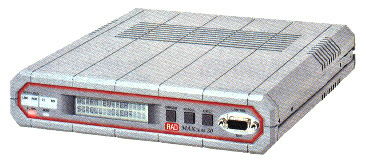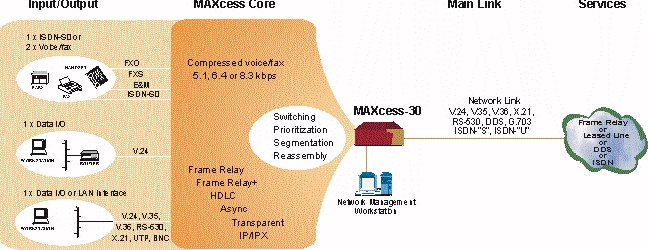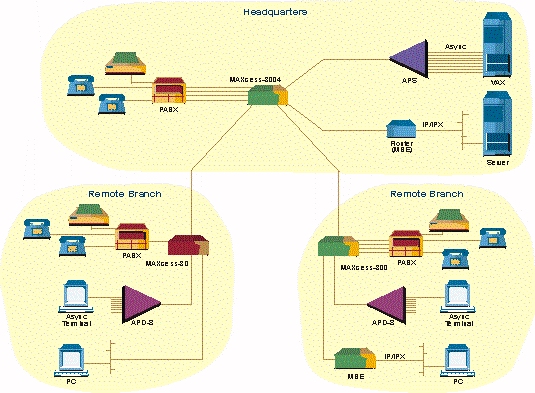
RAD MAXcess-30
FEATURES
- Integrates data, voice/fax and LAN over Frame Relay, ISDN or leased lines
- Two analog or one ISDN voice/fax port, and three data channels
- Voice interfaces include: FXS, FXO, E&M, ISDN-S0 (BRI)
- Voice compression rates of 5.1, 6.4 or 8.3 kbps using the RMP-MLQ algorithm
- Automatic voice/fax detection and enhanced voice switching
- Prioritization and packet segmentation for high quality voice over Frame Relay
- Dynamic bandwidth allocation
- IP/IPX routing, solid firewall, single IP address translation
- ISDN network connection as a backup or as a dial-up link (Connection on Demand)
- Point-to-point or feeder multiplexer to MAXcess-3000 networks
- Compact desktop unit
- Management via front panel, ASCII or Telnet terminal, or SNMP agent (RADView window-based application

DESCRIPTION
- MAXcess-30 integrates data, voice, fax and LAN traffic over leased lines, ISDN or Frame Relay networks. It supports three data channels and two analog voice/fax or one ISDN-S0 voice channels. LAN interconnectivity is provided via an external bridge or router, or an integral router.
- MAXcess-30 also operates as a compact multiprotocol FRAD, providing voice and data access to public or private Frame Relay networks. The FRAD capability is enhanced by an integrated CSU/DSU, which enables connection through a DDS network.
- Typical applications for the MAXcess-30 include:
– Point-to-point inter-office communication over leased lines, Frame Relay or ISDN
– Star configuration applications opposite a MAXcess-3000 hub at the central site
– FRAD applications for multiprotocol access to public or private Frame Relay networks. - MAXcess-30 network link interfaces are: V.35, V.24, V.36, RS-530 or X.21, with data rates up to 2 Mbps. In addition, either G.703 64/128 kbps, DDS-CSU/DSU, or basic rate ISDN “S” or “U” interface are supported.
- There are two data channels: one is V.24/RS-232 data channel, which supports data rates up to 128 kbps sync and 115.2 kbps async. The other data channel is V.24/RS-232, V.35, V.36, RS-530, which supports up to 2 Mbps, or Ethernet interface (10BaseT). See Ordering.
- Protocols supported are Frame Relay, FR+, HDLC, transparent or async, IP, IPX. Other protocols such as SDLC and X.25 can be encapsulated over Frame Relay.
- The solid firewall security feature protects an office LAN from undesired entry from the Internet. The single IP address translation feature allows a small or medium office LAN to connect to the Internet, using a single dynamically allocated IP address from the central access router. Connection on Demand (COD) allows the LAN to be connected to, or disconnected from the Internet, over ISDN, according to timeout, traffic or management.
- High quality voice compression at rates of 5.1, 6.4, 8.3 kbps, as well as silence suppression, facilitate maximum utilization of the bandwidth. In addition, priority mechanisms coupled with segmentation of long data frames ensure high quality voice transmission over leased lines or Frame Relay networks.
- Voice channel interfaces are:
– FXS – direct telephone connection
– FXO – PABX extension line 3. E&M
– PABX tie line (FXS supports DC feed and ringer voltage)
– ISDN-S0 PBX or a telephone extention. - The FAX support includes automatic fall-back to lower rates, in case of poor line quality.
- The network link can automatically detect and synchronize to the incoming clock rate, while the I/O data channels support most applications by enabling two clock modes: DCE or DTE.
- An integrated CSU/DSU unit is available as an option and supports data rates and services offered by the AT&T standard Digital Data Services (DDS). The CSU/DSU interface connects the user directly to a Standard DDS service that supports link data rates of 56 kbps. The DDS link is clocked from the recovered clock (loopback timing). Transmission range for the DDS link is up to 10.5 km (6.5 miles).
- The RADview-PC SNMP Windows-based application provides a user friendly GUI that facilitates setup and monitoring of any MAXcess network whether a small point-to-point application or a large corporate network. Remote management is provided by a dedicated DLCI, or via Telnet or modems on the control port.
- Setup, control and monitoring can be performed locally, using the front panel LCD, an ASCII terminal or the RADView-PC application.
- MAXcess-30 is a compact desktop unit. A rack mount kit is provided for 19″ rack installation.
APPLICATIONS

Figure 1 – MAXcess-30 Integrates Voice and Data over Network Link

Figure 2 – Connecting Remote Branches to Headquarters over Leased Lines
ORDERING
- MX-30
Office Bandwidth Manager - Specify network link (DTE):
V24 for V.24/RS-232 interface
V35 for V.35
V36 for V.36
530 for RS-530
X21 for X.21
DDS for DDS
703 for G.703
IBE for Basic Rate ISDN using “S” interface
IBU for Basic Rate ISDN using “U” interface - Specify high speed data channel #2 interface (channel 1 is always V.24/RS-232):
V24 for V.24 interface
V35 for V.35 interface
V36 for V.36 interface
530 for RS-530 interface
BNC for 10Base2
UTP for 10BaseT - Specify voice interfaces 1, 2:
E&M for E&M interface
FXO for FXO interface
FXS for FXS interface
S0 for ISDN-S0 interface
